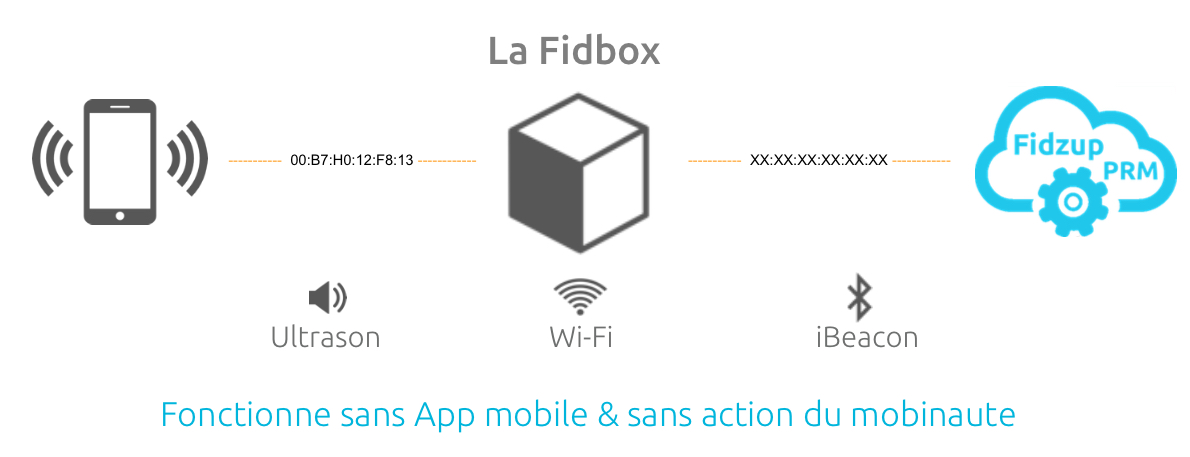
Fidzup est une start-up de 10 personnes, créée en 2011. Dirigée par Olivier Magnan-Saurin, Anh-Vu Nguyen et Christophe Noisel, elle propose d’adapter des outils du web pour le commerce physique. En quatre ans l’entreprise a levé 500 000 € et déposé deux brevets. Mais surtout, le 12 mars 2015, la jeune startup a remporté le trophée Espoir lors de la cérémonie de la Nuit des Rois. Retour sur une technologie innovante pour le retail.
I. Le constat
Ces entrepreneurs sont partis du constat que sur le web, tout ou presque est analysable : fréquence, durée de visite, parcours client, produits regardés / achetés, etc.
En point de vente physique en revanche c’est beaucoup moins facile. On peut certes compter le nombre de personnes, le nombre de passages en caisse ou le panier moyen, mais il est compliqué de connaître cas par cas les actions des clients/visiteurs.
Comment mieux connaitre son client sur son point de vente et comment mieux le driver ou le retargeter?
II. Le concept
Fidzup a donc créé Fidbox : un boitier regroupant 3 technologies (ultrason, iBeacon et Wi-fi) qui permet de capter 40% du trafic réel en magasin et d’étudier les actions et comportements du visiteur.
Il devient alors possible de récolter de la donnée similaire au web:
- visiteurs uniques
- durée des visites
- fréquence des visites
- zone chaudes/froides du magasin
- parcours client
- sorties rapides
- volume de smartphones
- marques et OS des terminaux

3. Pour quelle utilité ?
Fidzup a mis en place une interface analytics qui permet d’accéder à toutes les données récoltées et d’en apprendre plus sur ses clients/visiteurs et leurs comportements.
Et pour aller plus loin, Fidzup propose des outils de retargeting. De la même manière que sur le web, il est possible en fonction des données collectées de réactiver ses visiteurs directement sur le point de vente ou après son passage en magasin avec des publicités personnalisées via le propre Adnetwork de la startup.
Deux possibilités s’offrent alors au magasin :
- faire du retargeting quand le client n’est plus en magasin de la même façon que sur le web quand l'internaute a quitté un site ou abandonné son panier
ou
- faire du retargeting directement sur le point de vente. En fonction de ses actions, différents messages peuvent être envoyé au client/visiteur tout au long de son parcours.
Cette solution permet une interaction instantanée avec le visiteur via du contenu riche et interactif, de l’envoi automatisé de contenu géo-ciblé et contextualisé.
C’est aussi un moyen de Diffuser ses promotions, animer son point de vente et écouler ses reliquats.

Avec plus de 250 Fidbox déjà installées, plus de 5 millions de clients uniques en base de données et plus de 150 million de «foot traffic» couvert, Fidzup a conquis le jury de la Nuit des Rois : l’innovation est bien au rendez-vous, les acquis du marketing digital servent encore plus le offline.



 Tags:
Tags: 






.jpg)
.jpg)

 Cette lampe connectée aux faux airs de la mascotte de Pixar pourra s’adapter à vous et à votre style de vie. En effet, vous pourrez la programmer pour qu’elle s’éteigne quand vous quittez une pièce, qu’elle s’allume quand votre réveil sonne, ou même vous prévenir quand quelqu’un entre dans la pièce. Vous pourrez alors regarder les images grâce à la caméra intégrée. Et elle diffuse même de la musique !
Cette lampe connectée aux faux airs de la mascotte de Pixar pourra s’adapter à vous et à votre style de vie. En effet, vous pourrez la programmer pour qu’elle s’éteigne quand vous quittez une pièce, qu’elle s’allume quand votre réveil sonne, ou même vous prévenir quand quelqu’un entre dans la pièce. Vous pourrez alors regarder les images grâce à la caméra intégrée. Et elle diffuse même de la musique ! Pour piloter votre Lumismart, vous aurez besoin de l’application compatible iOS ou Android. Grâce à celle-ci, vous pourrez programmer vos scénarios, regarder votre pièce grâce à la caméra, allumer ou éteindre la lampe… Et si vous vous sentez l’âme d’un bidouilleur, vous pourrez créer vos propres applications pour personnaliser au mieux votre Lumismart.
Pour piloter votre Lumismart, vous aurez besoin de l’application compatible iOS ou Android. Grâce à celle-ci, vous pourrez programmer vos scénarios, regarder votre pièce grâce à la caméra, allumer ou éteindre la lampe… Et si vous vous sentez l’âme d’un bidouilleur, vous pourrez créer vos propres applications pour personnaliser au mieux votre Lumismart.











